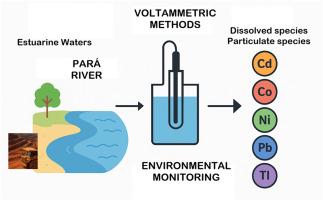巴西帕尔河河口环境监测中电活性微量元素的分布
IF 8.1
2区 环境科学与生态学
Q1 ENVIRONMENTAL SCIENCES
引用次数: 0
摘要
在过去的几十年里,采矿活动被认为对亚马逊地区的环境有很大的影响。此外,该地区日益增长的城市化和港口活动也与环境影响以及有毒金属对水生生态系统的生物利用度风险直接相关。本文研究了在par本文章由计算机程序翻译,如有差异,请以英文原文为准。

Distribution of trace elements as electroactive species for environmental monitoring of estuarine waters in Pará river (AAmazonia, Brazil)
Mining activities have been recognized as having a high environmental impact in the Amazon region in the last decades. In addition, the growing urbanization and port activities in the region are also directly linked to environmental impacts, and the risk of bioavailability of toxic metals to aquatic ecosystems. This work presents a study of the distribution of Cd(II), Pb(II), Ni(II), Co(II), and Tl(I) in the dissolved (total and reactive, <0.2 μm) and particulate (>0.2 μm) fractions in water samples collected close to ore refining sites within the Pará River estuarine zone. As an analytical strategy, the sequential determination of the metals was performed by highly sensitive voltammetric methods. The speciation analysis of the elements was based on the size fractionation by filtration through 0.2 μm membrane filters to obtain the dissolved (<0.2 μm) and labile particulate (>0.2 μm) fractions. The metallic dissolved species were quantified in concentrations ranging from <0.023 to ∼0.25 μg L−1 for Cd(II), Co(II), Tl(I), and <0.20–∼7.0 μg L−1 for Ni(II) and Pb(II). For the total dissolved species, a distribution pattern was observed in both dry and rainy seasons, which indicates a possible local anthropic influence. Cadmium and thallium presented similar distribution patterns concerning the lower concentration of reactive species compared to the other metals. On the other side, reactive species of cobalt, lead and nickel, were found be distributed within the study area in concentrations close to total dissolved species, regardless of seasonality. The highest particulate species were detected in the reference points of the study area, indicating that the elements are predominantly associated with particles in the areas without anthropogenic influences. The speciation studies suggest that there is a dynamic transition between dissolved and particulate phases, possibly controlled by factors such as adsorption/desorption and interactions with organic matter in this estuarine region.
求助全文
通过发布文献求助,成功后即可免费获取论文全文。
去求助
来源期刊

Chemosphere
环境科学-环境科学
CiteScore
15.80
自引率
8.00%
发文量
4975
审稿时长
3.4 months
期刊介绍:
Chemosphere, being an international multidisciplinary journal, is dedicated to publishing original communications and review articles on chemicals in the environment. The scope covers a wide range of topics, including the identification, quantification, behavior, fate, toxicology, treatment, and remediation of chemicals in the bio-, hydro-, litho-, and atmosphere, ensuring the broad dissemination of research in this field.
 求助内容:
求助内容: 应助结果提醒方式:
应助结果提醒方式:


